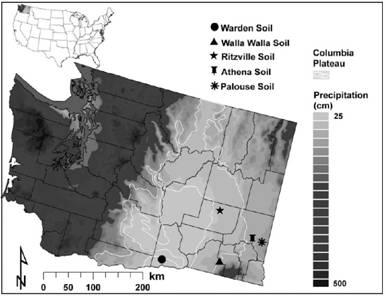Soil wind erosion and fugitive dust emission contribute to land degradation, loss of soil productivity, and poor air quality and visibility. The potential for wind erosion is highest in arid and semiarid regions. During high wind events, soil entrainment is dominated by suspension processes. Soil and mineral particles with a diameter <60 μm are especially important to air quality because they contain significant amounts of soil nutrients and contaminants. Of particular concern are those particles with a mean aerodynamic diameter ≤10 μm (PM10) and 2.5 μm (PM2.5) which are stringently regulated by Environmental Protection Agency (EPA) as air pollutants.
To characterize the PM10 and PM2.5 emission potential of soils in the Inland Pacific Northwest, researchers collected soil from the upper 3-cm layer of the profile from five major soil types in southeastern Washington. Soil samples collected from the field were placed inside a wind tunnel to simultaneously measure PM10 and PM2.5 emissions at three wind speeds. Dispersed soil analysis indicated that the sand and silt content, respectively, ranged from 17% to 68% and 23% to 66% while nondispersed soil analysis revealed the PM10 and PM2.5 content averaged 3.7% and 1.2%, respectively, across the five soil types. Emissions of PM10 and PM2.5 were greatest for Warden sandy loam (coarse-silty, mixed, superactive, mesic Xeric Haplocambids) and lowest for Walla silt loam (coarse-silty, mixed, superactive, mesic Typic Haploxerolls). During the 5 min wind tunnel test at the highest wind speed (18 m s-1), loss of sediment, PM10 and PM2.5 for the five soils ranged from 113 to 8039 g m-2, 0.4 to 11.0 g m-2, and 0.1 to 6.0 g m-2, respectively. Although the PM10/sediment loss ratio differed among soils, there was no difference in the PM2.5/sediment loss ratio across soils. Their results suggest that the emission potential varies for windblown soils found across the Inland Pacific Northwest. In addition, differences in dispersed and nondispersed PM10 and PM2.5 content show that management practices play a significant role in coagulation of the fine particles onto larger, less erodible aggregates for reducing dust emission from farmland.
This work has been published on Soil Science Society of America Journal, 2011, 75(6): 2262-2270. This paper is also archived at https://www.soils.org/publications/sssaj/articles/75/6/2262.

Soil sampling sites and annual average precipitation within the Columbia Plateau of Washington state

